2010 KIA SORENTO engine coolant
[x] Cancel search: engine coolantPage 328 of 399

Maintenance
22
7
Vapor hose and fuel filler cap
The vapor hose and fuel filler cap should
be inspected at those intervals specified
in the maintenance schedule. Make sure
that a new vapor hose or fuel filler cap iscorrectly replaced.
Vacuum crankcase ventilation hoses (if equipped)
Inspect the surface of hoses for evidence
of heat and/or mechanical damage. Hard
and brittle rubber, cracking, tears, cuts,
abrasions, and excessive swelling indi-
cate deterioration. Particular attention
should be paid to examine those hose
surfaces nearest to high heat sources,
such as the exhaust manifold. Inspect the hose routing to assure that the hoses do not come in contact with
any heat source, sharp edges or movingcomponent which might cause heat dam-
age or mechanical wear. Inspect all hose
connections, such as clamps and cou-
plings, to make sure they are secure, and
that no leaks are present. Hoses should
be replaced immediately if there is any
evidence of deterioration or damage. Air cleaner filter
A Genuine KIA air cleaner filter is recom- mended when the filter is replaced.
Spark plugs (for gasoline engine)
Make sure to install new spark plugs of
the correct heat range.
Valve clearance
(for gasoline engine)
Inspect for excessive valve noise and/or
engine vibration and adjust if necessary.
An authorized KIA dealer should perform
the operation. Cooling system
Check the cooling system components,
such as the radiator, coolant reservoir,
hoses and connections for leakage and
damage. Replace any damaged parts. Coolant The coolant should be changed at the
intervals specified in the maintenance
schedule.
Manual transaxle fluid (if equipped)
Inspect the manual transaxle fluid
according to the maintenance schedule.
Automatic transaxle fluid (if equipped)
Automatic transaxle fluid should not be
checked under normal usage conditions.
But in severe conditions, the fluid should
be changed at an authorized KIA dealerin accordance to the scheduled mainte-
nance at the beginning of this chapter.
✽✽
NOTICE
Automatic transaxle fluid color is basi-
cally red.
As the vehicle is driven, the automatic
transaxle fluid will begin to look darker.
It is normal condition and you should
not judge the need to replace the fluid
based upon the changed color.
CAUTION
The use of a non-specified fluid could result in transaxle malfunc-
tion and failure.
Use only specified automatictransaxle fluid. (Refer to “Recommended lubricants andcapacities” in section 8.)
Page 331 of 399
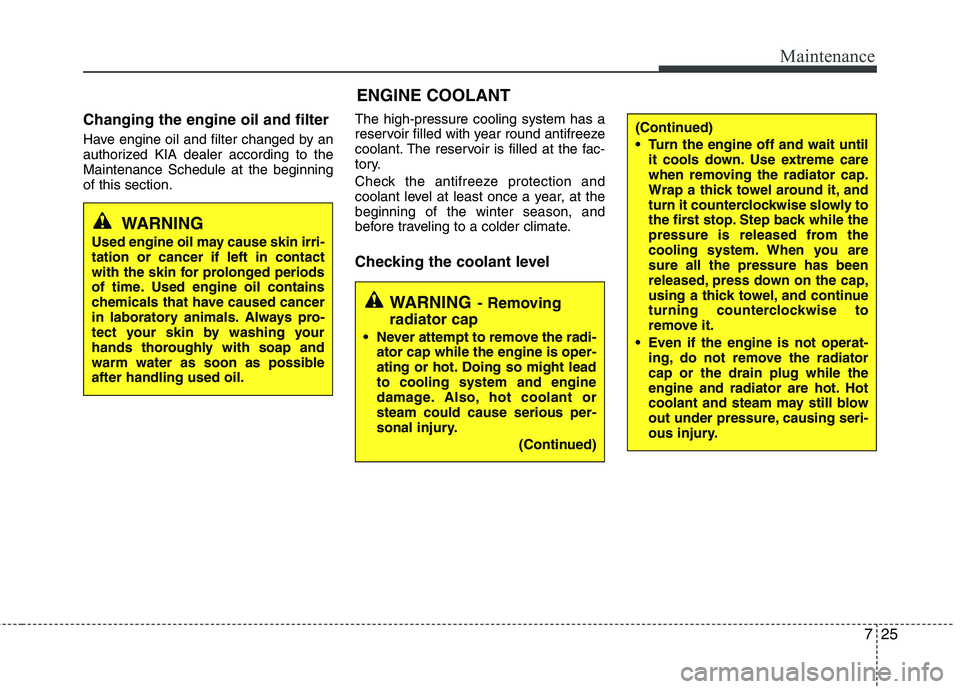
725
Maintenance
Changing the engine oil and filter
Have engine oil and filter changed by an
authorized KIA dealer according to theMaintenance Schedule at the beginningof this section.The high-pressure cooling system has a
reservoir filled with year round antifreeze
coolant. The reservoir is filled at the fac-
tory.
Check the antifreeze protection and
coolant level at least once a year, at thebeginning of the winter season, and
before traveling to a colder climate.
Checking the coolant level
WARNING
Used engine oil may cause skin irri- tation or cancer if left in contact
with the skin for prolonged periods
of time. Used engine oil contains
chemicals that have caused cancer
in laboratory animals. Always pro-
tect your skin by washing your
hands thoroughly with soap and
warm water as soon as possibleafter handling used oil.
ENGINE COOLANT
WARNING - Removing
radiator cap
Never attempt to remove the radi- ator cap while the engine is oper-
ating or hot. Doing so might leadto cooling system and engine
damage. Also, hot coolant orsteam could cause serious per-
sonal injury.
(Continued)
(Continued)
Turn the engine off and wait untilit cools down. Use extreme care
when removing the radiator cap.
Wrap a thick towel around it, and
turn it counterclockwise slowly to
the first stop. Step back while the
pressure is released from the
cooling system. When you aresure all the pressure has been
released, press down on the cap,
using a thick towel, and continue
turning counterclockwise to
remove it.
Even if the engine is not operat- ing, do not remove the radiatorcap or the drain plug while the
engine and radiator are hot. Hot
coolant and steam may still blow
out under pressure, causing seri-
ous injury.
Page 332 of 399
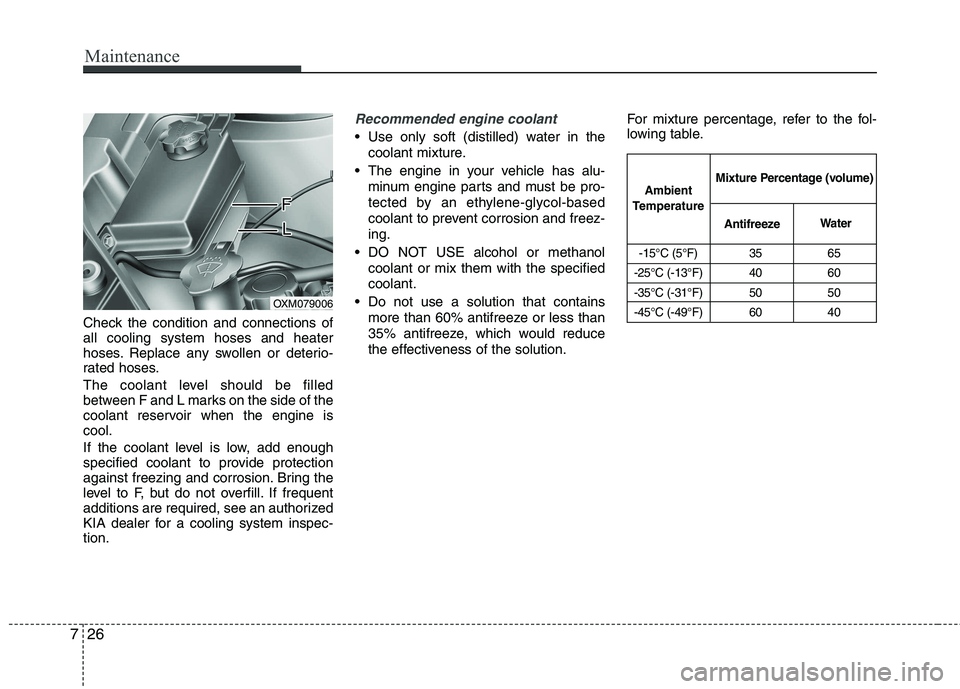
Maintenance
26
7
Check the condition and connections of all cooling system hoses and heater
hoses. Replace any swollen or deterio-
rated hoses.
The coolant level should be filled
between F and L marks on the side of the
coolant reservoir when the engine iscool.
If the coolant level is low, add enough
specified coolant to provide protection
against freezing and corrosion. Bring the
level to F, but do not overfill. If frequent
additions are required, see an authorized
KIA dealer for a cooling system inspec-tion.
Recommended engine coolant
Use only soft (distilled) water in the
coolant mixture.
The engine in your vehicle has alu- minum engine parts and must be pro-
tected by an ethylene-glycol-based
coolant to prevent corrosion and freez-ing.
DO NOT USE alcohol or methanol coolant or mix them with the specifiedcoolant.
Do not use a solution that contains more than 60% antifreeze or less than
35% antifreeze, which would reduce
the effectiveness of the solution. For mixture percentage, refer to the fol-
lowing table.
OXM079006
-15°C (5°F) 35 65
-25°C (-13°F) 40 60
-35°C (-31°F) 50 50
-45°C (-49°F) 60 40
Ambient
Temperature Mixture Percentage (volume)
Antifreeze Water
Page 333 of 399
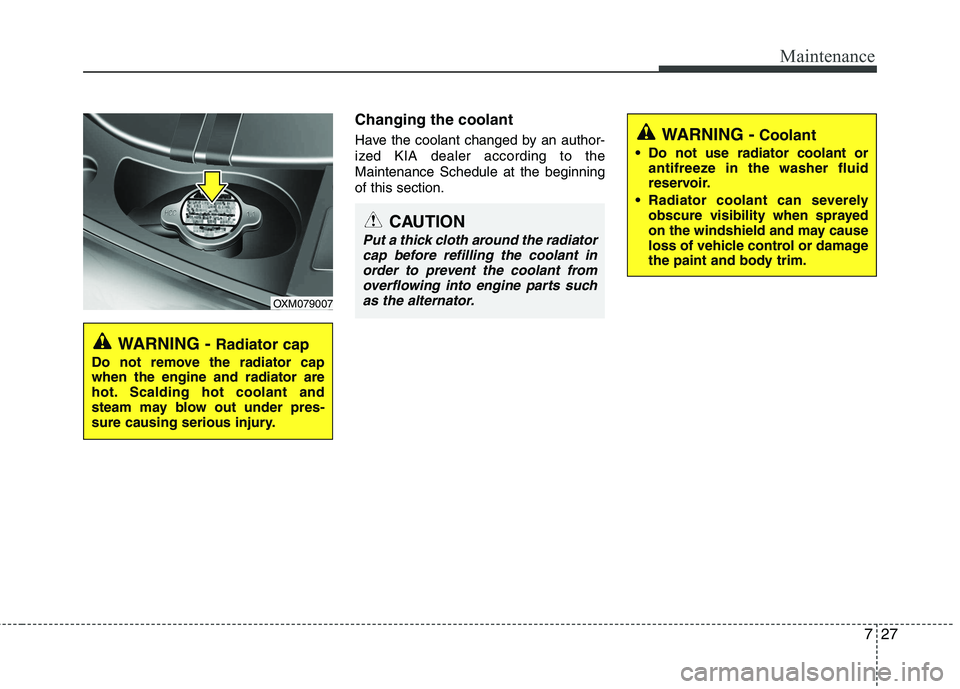
727
Maintenance
Changing the coolant
Have the coolant changed by an author-
ized KIA dealer according to theMaintenance Schedule at the beginningof this section.
WARNING - Radiator cap
Do not remove the radiator cap when the engine and radiator are
hot. Scalding hot coolant and
steam may blow out under pres-
sure causing serious injury.
OXM079007
CAUTION
Put a thick cloth around the radiator cap before refilling the coolant in order to prevent the coolant from
overflowing into engine parts suchas the alternator.
WARNING - Coolant
Do not use radiator coolant or antifreeze in the washer fluid
reservoir.
Radiator coolant can severely obscure visibility when sprayed
on the windshield and may cause
loss of vehicle control or damage
the paint and body trim.
Page 385 of 399
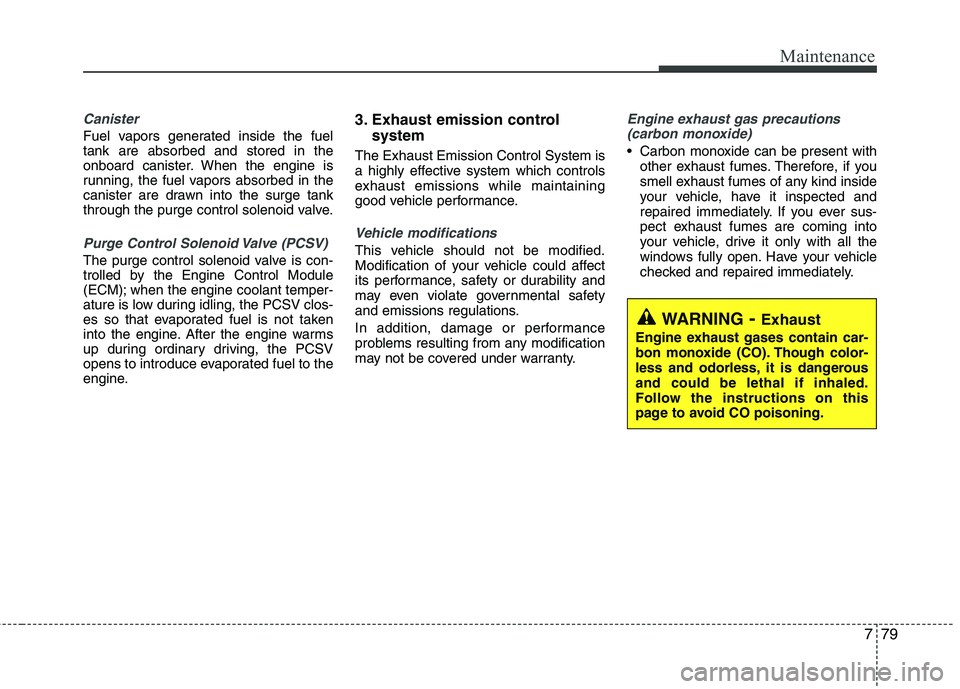
779
Maintenance
Canister
Fuel vapors generated inside the fuel tank are absorbed and stored in the
onboard canister. When the engine is
running, the fuel vapors absorbed in the
canister are drawn into the surge tank
through the purge control solenoid valve.
Purge Control Solenoid Valve (PCSV)
The purge control solenoid valve is con-
trolled by the Engine Control Module
(ECM); when the engine coolant temper-
ature is low during idling, the PCSV clos-
es so that evaporated fuel is not taken
into the engine. After the engine warms
up during ordinary driving, the PCSV
opens to introduce evaporated fuel to the
engine.3. Exhaust emission control
system
The Exhaust Emission Control System is
a highly effective system which controls
exhaust emissions while maintaining
good vehicle performance.
Vehicle modifications
This vehicle should not be modified.
Modification of your vehicle could affect
its performance, safety or durability and
may even violate governmental safety
and emissions regulations.
In addition, damage or performance
problems resulting from any modification
may not be covered under warranty.
Engine exhaust gas precautions (carbon monoxide)
Carbon monoxide can be present with other exhaust fumes. Therefore, if you
smell exhaust fumes of any kind inside
your vehicle, have it inspected and
repaired immediately. If you ever sus-
pect exhaust fumes are coming into
your vehicle, drive it only with all the
windows fully open. Have your vehicle
checked and repaired immediately.
WARNING - Exhaust
Engine exhaust gases contain car-
bon monoxide (CO). Though color-
less and odorless, it is dangerousand could be lethal if inhaled.
Follow the instructions on this
page to avoid CO poisoning.
Page 391 of 399
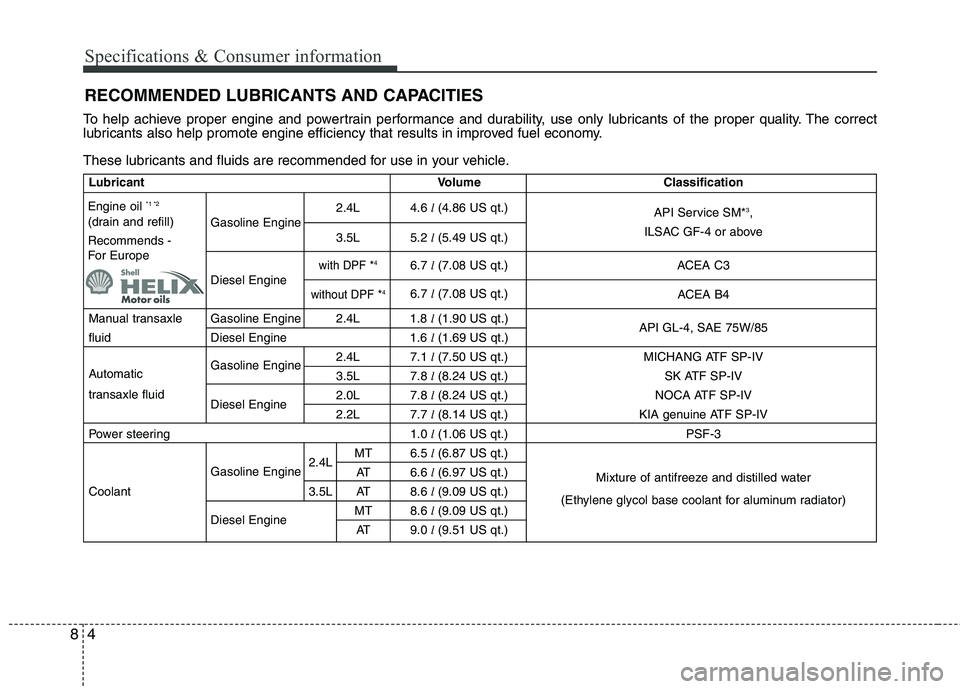
Specifications & Consumer information
4
8
RECOMMENDED LUBRICANTS AND CAPACITIES
To help achieve proper engine and powertrain performance and durability, use only lubricants of the proper quality. The correct
lubricants also help promote engine efficiency that results in improved fuel economy.
These lubricants and fluids are recommended for use in your vehicle.
Lubricant Volume Classification
2.4L 4.6 l (4.86 US qt.)
API Service SM*3
,
Gasoline Engine
3.5L 5.2 l (5.49 US qt.) ILSAC GF-4 or above
with DPF *
46.7
l (7.08 US qt.) ACEA C3
Diesel Engine 6.7 l (7.08 US qt.)
without DPF * 4ACEA B4
Manual transaxle Gasoline Engine 2.4L 1.8 l(1.90 US qt.)
API GL-4, SAE 75W/85
fluid Diesel Engine 1.6 l(1.69 US qt.)
Automatic 2.4L 7.1
l (7.50 US qt.) MICHANG ATF SP-IV
transaxle fluid Gasoline Engine
3.5L 7.8 l (8.24 US qt.) SK ATF SP-IV
Diesel Engine 2.0L 7.8
l (8.24 US qt.) NOCA ATF SP-IV
2.2L 7.7 l (8.14 US qt.) KIA genuine ATF SP-IV
Power steering 1.0 l (1.06 US qt.) PSF-3
Gasoline Engine 2.4LMT 6.5
l (6.87 US qt.)
Mixture of antifreeze and distilled water
AT 6.6
l (6.97 US qt.)
Coolant 3.5L AT 8.6 l (9.09 US qt.)
Diesel Engine MT 8.6
l (9.09 US qt.) (Ethylene glycol base coolant for aluminum radiator)
AT 9.0 l (9.51 US qt.)
Engine oil *1 *2
(drain and refill) Recommends -
For Europe
Page 397 of 399
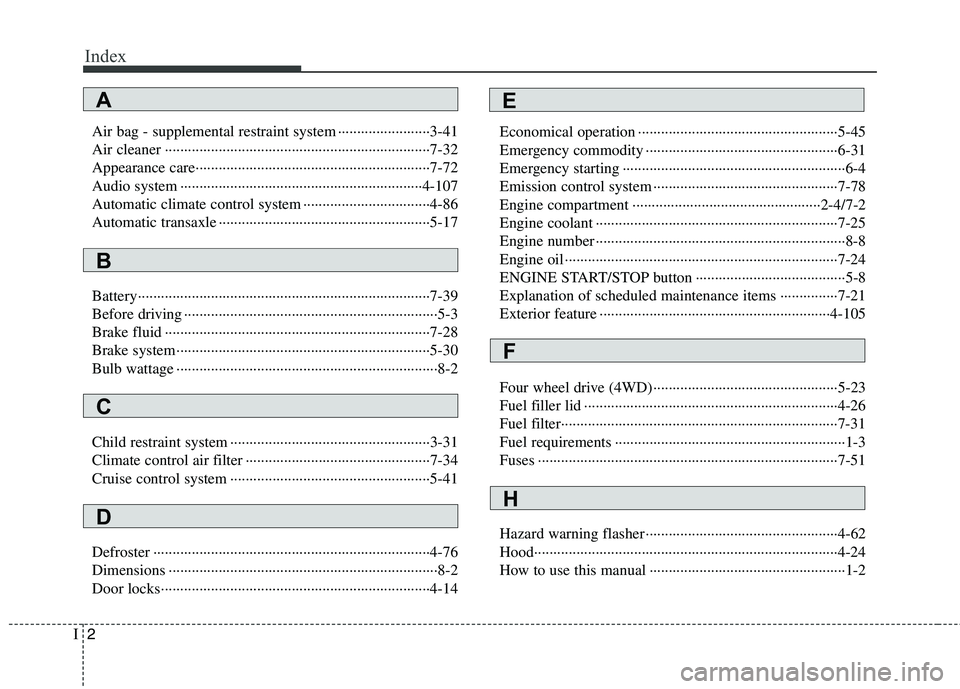
Index
2
I
Air bag - supplemental restraint system ························3-41
Air cleaner ·····································································7-32
Appearance care·····························································7-72
Audio system ·······························································4-107
Automatic climate control system ·································4-86
Automatic transaxle ·······················································5-17
Battery············································································7-39
Before driving ··································································5-3
Brake fluid ·····································································7-28
Brake system··································································5-30
Bulb wattage ····································································8-2
Child restraint system ····················································3-31
Climate control air filter ················································7-34
Cruise control system ····················································5-41
Defroster ········································································4-76
Dimensions ······································································8-2
Door locks······································································4-14 Economical operation ····················································5-45
Emergency commodity ··················································6-31
Emergency starting ··························································6-4
Emission control system ················································7-78
Engine compartment ·················································2-4/7-2
Engine coolant ·······························································7-25
Engine number ·································································8-8
Engine oil ·······································································7-24
ENGINE START/STOP button ·······································5-8
Explanation of scheduled maintenance items ···············7-21
Exterior feature ····························································4-105
Four wheel drive (4WD)················································5-23
Fuel filler lid ··································································4-26
Fuel filter········································································7-31
Fuel requirements ····························································1-3
Fuses ··············································································7-51
Hazard warning flasher ··················································4-62
Hood···············································································4-24
How to use this manual ···················································1-2
A
B
C
D
E
F
H